Dual Network Co-Crosslinked HNBR Composites with Enhanced Tribological Properties under Water Lubrication
Abstract
:1. Introduction
2. Materials and Methods
2.1. Materials
2.2. Preparation
2.2.1. Preparation of Epoxidized Eucommia Ulmoides Gum
2.2.2. Preparation of HNBR/EEUG Composites
2.2.3. Preparation of Dual Network Co-Crosslinked Composites
2.3. Tribological Tests
2.4. Characterizations
3. Results and Discussions
3.1. EEUG Characterization
3.2. Mechanical Properties of Composite Materials
3.3. Damping Analysis of Composites
3.4. Tribological Properties of Composites
3.4.1. Tribological Properties of HNBR/EEUG
3.4.2. Frictional Properties of Dual Network Co-Crosslinked Composites
3.5. Microscopic Morphology Analysis
3.6. Water Contact Angle
3.7. Long-Term Wear Test
4. Conclusions
Author Contributions
Funding
Data Availability Statement
Conflicts of Interest
References
- Wang, J.; Yan, F.; Xue, Q. Tribological behaviors of some polymeric materials in sea water. Sci. Bull. 2009, 54, 4541–4548. [Google Scholar] [CrossRef]
- Litwin, W. Experimental research on water lubricated three layer sliding bearing with lubrication grooves in the upper part of the bush and its comparison with a rubber bearing. Tribol. Int. 2015, 82, 153–161. [Google Scholar] [CrossRef]
- Zhou, G.; Wu, K.; Pu, W.; Li, P.; Han, Y. Tribological modification of hydrogenated nitrile rubber nanocomposites for water-lubricated bearing of ship stern shaft. Wear 2022, 504–505, 204432. [Google Scholar] [CrossRef]
- Masuko, M.; Suzuki, A.; Sagae, Y.; Tokoro, M.; Yamamoto, K. Friction characteristics of inorganic or organic thin coatings on solid surfaces under water lubrication. Tribol. Int. 2006, 39, 1601–1608. [Google Scholar] [CrossRef]
- Yamamoto, K.; Matsukado, K. Effect of hydrogenated DLC coating hardness on the tribological properties under water lubrication. Tribol. Int. 2006, 39, 1609–1614. [Google Scholar] [CrossRef]
- Mou, Z.; Yan, R.; Peng, J.; Li, Y.; Huang, Z.; Wang, Z.; Zhao, B.; Xiao, D. Synthesis of polyzwitterionic carbon dots with superior friction and fatigue control behaviors under water lubrication. Chem. Eng. J. 2023, 465, 142986. [Google Scholar] [CrossRef]
- Vadivel, H.S.; Golchin, A.; Emami, N. Tribological behaviour of carbon filled hybrid UHMWPE composites in water. Tribol. Int. 2018, 124, 169–177. [Google Scholar] [CrossRef]
- Liu, S.; Luo, J.; Li, G.; Zhang, C.; Lu, X. Effect of surface physicochemical properties on the lubricating properties of water film. Appl. Surf. Sci. 2008, 254, 7137–7142. [Google Scholar] [CrossRef]
- Wu, Z.; Guo, Z.; Yuan, C. Influence of polyethylene wax on wear resistance for polyurethane composite material under low speed water-lubricated conditions. Wear 2019, 426–427, 1008–1017. [Google Scholar] [CrossRef]
- Wang, Q.; Zhou, F. Progress in Tribological Properties of Nano-Composite Hard Coatings under Water Lubrication. Lubricants 2017, 5, 5. [Google Scholar] [CrossRef]
- Qu, C.; Zhang, N.; Wang, C.; Wang, T.; Wang, Q.; Li, S.; Chen, S. MoS2/CF synergistic reinforcement on tribological properties of NBR/PU/EP interpenetrating polymer networks. Tribol. Int. 2022, 167, 107384. [Google Scholar] [CrossRef]
- Zang, L.; Chen, D.; Cai, Z.; Peng, J.; Zhu, M. Preparation and damping properties of an organic–inorganic hybrid material based on nitrile rubber. Compos. Part B Eng. 2018, 137, 217–224. [Google Scholar] [CrossRef]
- Zhou, Y.-J.; Wang, D.-G.; Guo, Y.-B. The Reduction of Static Friction of Rubber Contact under Sea Water Droplet Lubrication. Lubricants 2017, 5, 12. [Google Scholar] [CrossRef]
- Litwin, W. Properties comparison of rubber and three layer PTFE-NBR-bronze water lubricated bearings with lubricating grooves along entire bush circumference based on experimental tests. Tribol. Int. 2015, 90, 404–411. [Google Scholar] [CrossRef]
- Narynbek Ulu, K.; Huneau, B.; Verron, E.; Béranger, A.S.; Heuillet, P. Effects of acrylonitrile content and hydrogenation on fatigue behaviour of HNBR. Fatigue Fract. Eng. Mater. Struct. 2019, 42, 1578–1594. [Google Scholar] [CrossRef]
- Yeo, Y.-G.; Park, H.-H.; Lee, C.-S. A study on the characteristics of a rubber blend of fluorocarbon rubber and hydrogenated nitrile rubber. J. Ind. Eng. Chem. 2013, 19, 1540–1548. [Google Scholar] [CrossRef]
- Dong, C.; Shi, L.; Li, L.; Bai, X.; Yuan, C.; Tian, Y. Stick-slip behaviours of water lubrication polymer materials under low speed conditions. Tribol. Int. 2017, 106, 55–61. [Google Scholar] [CrossRef]
- Marian, M.; Berman, D.; Nečas, D.; Emami, N.; Ruggiero, A.; Rosenkranz, A. Roadmap for 2D materials in biotribological/biomedical applications–A review. Adv. Colloid Interface Sci. 2022, 307, 102747. [Google Scholar] [CrossRef]
- Chen, H.; Cai, T.; Ruan, X.; Jiao, C.; Xia, J.; Wei, X.; Wang, Y.; Gong, P.; Li, H.; Atkin, R.; et al. Outstanding Bio-Tribological Performance Induced by the Synergistic Effect of 2D Diamond Nanosheet Coating and Silk Fibroin. ACS Appl. Mater. Interfaces 2022, 14, 48091–48105. [Google Scholar] [CrossRef]
- Zhang, L.; Xie, G.; Wu, S.; Peng, S.; Zhang, X.; Guo, D.; Wen, S.; Luo, J. Ultralow friction polymer composites incorporated with monodispersed oil microcapsules. Friction 2019, 9, 29–40. [Google Scholar] [CrossRef]
- Li, Z.; Li, K.; Li, X.; Feng, Y.; Li, H.; Wang, H. Preparation of linseed oil-loaded porous glass bubble/wax microcapsules for corrosion- and wear-resistant difunctional coatings. Chem. Eng. J. 2022, 437, 135403. [Google Scholar] [CrossRef]
- Zhang, J.; Wang, L.; Zhao, Y. Understanding interpenetrating-polymer-network-like porous nitrile butadiene rubber hybrids by their long-period miscibility. Mater. Des. 2013, 51, 648–657. [Google Scholar] [CrossRef]
- Emerson, J.A.; Garabedian, N.T.; Moore, A.C.; Burris, D.L.; Furst, E.M.; Epps, T.H. Unexpected Tribological Synergy in Polymer Blend Coatings: Leveraging Phase Separation to Isolate Domain Size Effects and Reduce Friction. ACS Appl. Mater. Interfaces 2017, 9, 34480–34488. [Google Scholar] [CrossRef]
- Liu, Y.; Shuai, C.; Lu, G.; Yang, X.; Hu, X. Preparation of polyethylene glycol brush grafted from the surface of nitrile butadiene rubber with excellent tribological performance under aqueous lubrication. Mater. Des. 2022, 224, 111310. [Google Scholar] [CrossRef]
- Xu, J.; Zhang, C.; Luo, J. Hydration Lubrication Applicable to Artificial Joints through Polyelectrolyte-Embedded Modification on UHMWPE. ACS Appl. Polym. Mater. 2022, 4, 7487–7497. [Google Scholar] [CrossRef]
- Chudzik, J.; Bielinski, D.M.; Demchuk, Y.; Bratychak, M.; Astakhova, O. Influence of Modified Epoxy Dian Resin on Properties of Nitrile-Butadiene Rubber (NBR). Materials 2022, 15, 2766. [Google Scholar] [CrossRef]
- Sang, J.; Sato, R.; Aisawa, S.; Hirahara, H.; Mori, K. Hybrid joining of polyamide and hydrogenated acrylonitrile butadiene rubber through heat-resistant functional layer of silane coupling agent. Appl. Surf. Sci. 2017, 412, 121–130. [Google Scholar] [CrossRef]
- Yang, F.; Dai, L.; Liu, T.; Zhou, J.; Fang, Q. Preparation of high-damping soft elastomer based on Eucommia ulmoides gum. Polym. Bull. 2019, 77, 33–47. [Google Scholar] [CrossRef]
- Dong, M.; Zhang, T.; Zhang, J.; Hou, G.; Yu, M.; Liu, L. Mechanism analysis of Eucommia ulmoides gum reducing the rolling resistance and the application study in green tires. Polym. Test. 2020, 87, 106539. [Google Scholar] [CrossRef]
- Wang, Y.; Liu, J.; Xia, L.; Shen, M.; Xin, Z.; Kim, J. Role of epoxidized natural Eucommia ulmoides gum in modifying the interface of styrene-butadiene rubber/silica composites. Polym. Adv. Technol. 2019, 30, 2968–2976. [Google Scholar] [CrossRef]
- Chen, B.; Wu, Q.; Li, J.; Lin, K.; Chen, D.; Zhou, C.; Wu, T.; Luo, X.; Liu, Y. A novel and green method to synthesize a epoxidized biomass eucommia gum as the nanofiller in the epoxy composite coating with excellent anticorrosive performance. Chem. Eng. J. 2020, 379, 122323. [Google Scholar] [CrossRef]
- Wang, Y.; Liu, J.; Xia, L.; Shen, M.; Xin, Z. Super-tough poly(lactic acid) thermoplastic vulcanizates with heat triggered shape memory behaviors based on modified natural Eucommia ulmoides gum. Polym. Test. 2019, 80, 106077. [Google Scholar] [CrossRef]
- Qi, X.; Pan, C.; Zhang, L.; Yue, D. Bio-Based, Self-Healing, Recyclable, Reconfigurable Multifunctional Polymers with Both One-Way and Two-Way Shape Memory Properties. ACS Appl. Mater. Interfaces 2023, 15, 3497–3506. [Google Scholar] [CrossRef]
- Li, D.; Zhou, J.; Kang, H.; Li, L.; Han, W.; Fang, Q.; Wang, N.; Yang, F. Synthesis and properties of an efficient self-healing material based on Eucommia ulmoides gum. Ind. Crops Prod. 2022, 187, 115385. [Google Scholar] [CrossRef]
- Yue, P.-P.; Rao, J.; Leng, Z.-J.; Chen, G.-G.; Hao, X.; Peng, P.; Peng, F. An electrospun composite of epoxidized Eucommia ulmoides gum and SiO2-GO with ultraviolet resistance. J. Mater. Sci. 2022, 57, 4862–4875. [Google Scholar] [CrossRef]
- Qu, C.; Wang, T.; Wang, Q.; Chen, S. A novel ternary interpenetrating polymer networks based on NBR/PU/EP with outstanding damping and tribological properties for water-lubricated bearings. Tribol. Int. 2022, 167, 107249. [Google Scholar] [CrossRef]
- de Kraker, A.; van Ostayen, R.A.J.; Rixen, D.J. Calculation of Stribeck curves for (water) lubricated journal bearings. Tribol. Int. 2007, 40, 459–469. [Google Scholar] [CrossRef]
- Yu, P.; Li, G.; Zhang, L.; Zhao, F.; Guo, Y.; Pei, X.-Q.; Zhang, G. Role of SiC submicron-particles on tribofilm growth at water-lubricated interface of polyurethane/epoxy interpenetrating network (PU/EP IPN) composites and steel. Tribol. Int. 2021, 153, 106611. [Google Scholar] [CrossRef]
- Fukahori, Y.; Gabriel, P.; Liang, H.; Busfield, J.J.C. A new generalized philosophy and theory for rubber friction and wear. Wear 2020, 446–447, 203166. [Google Scholar] [CrossRef]
- Yin, T.; Wei, D.; Wang, T.; Xie, Z. Thermal compression and accumulation effect on lubrication regime transition mechanism of water seal. Tribol. Int. 2023, 181, 108285. [Google Scholar] [CrossRef]
- Hale, J.; Lewis, R.; Carré, M.J. Rubber friction and the effect of shape. Tribol. Int. 2020, 141, 105911. [Google Scholar] [CrossRef]
- Bai, C.; Qiang, L.; Zhang, B.; Gao, K.; Zhang, J. Optimizing the tribological performance of DLC-coated NBR rubber: The role of hydrogen in films. Friction 2021, 10, 866–877. [Google Scholar] [CrossRef]
- Emami, A.; Khaleghian, S.; Taheri, S. Asperity-based modification on theory of contact mechanics and rubber friction for self-affine fractal surfaces. Friction 2021, 9, 1707–1725. [Google Scholar] [CrossRef]
- Zhao, G.; Wang, T.; Wang, Q. Studies on wettability, mechanical and tribological properties of the polyurethane composites filled with talc. Appl. Surf. Sci. 2012, 258, 3557–3564. [Google Scholar] [CrossRef]

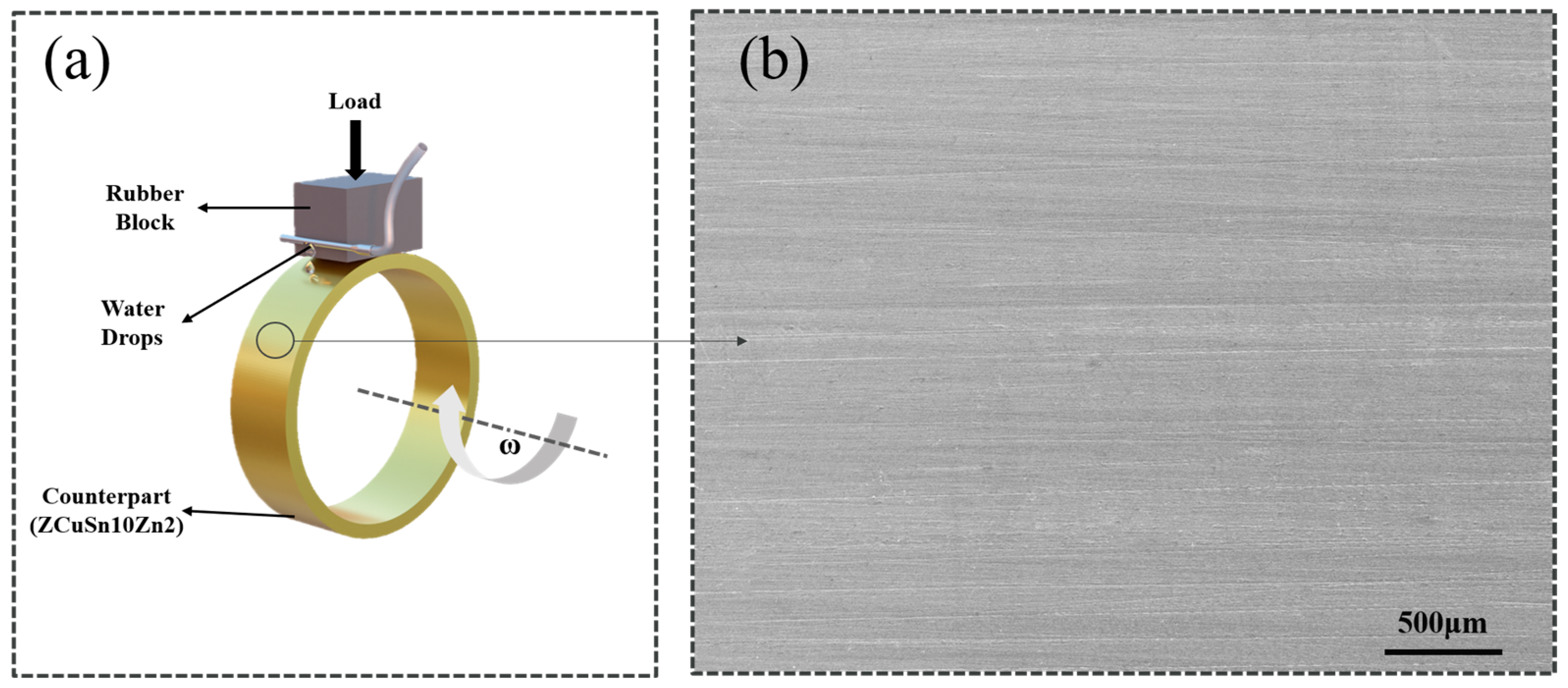
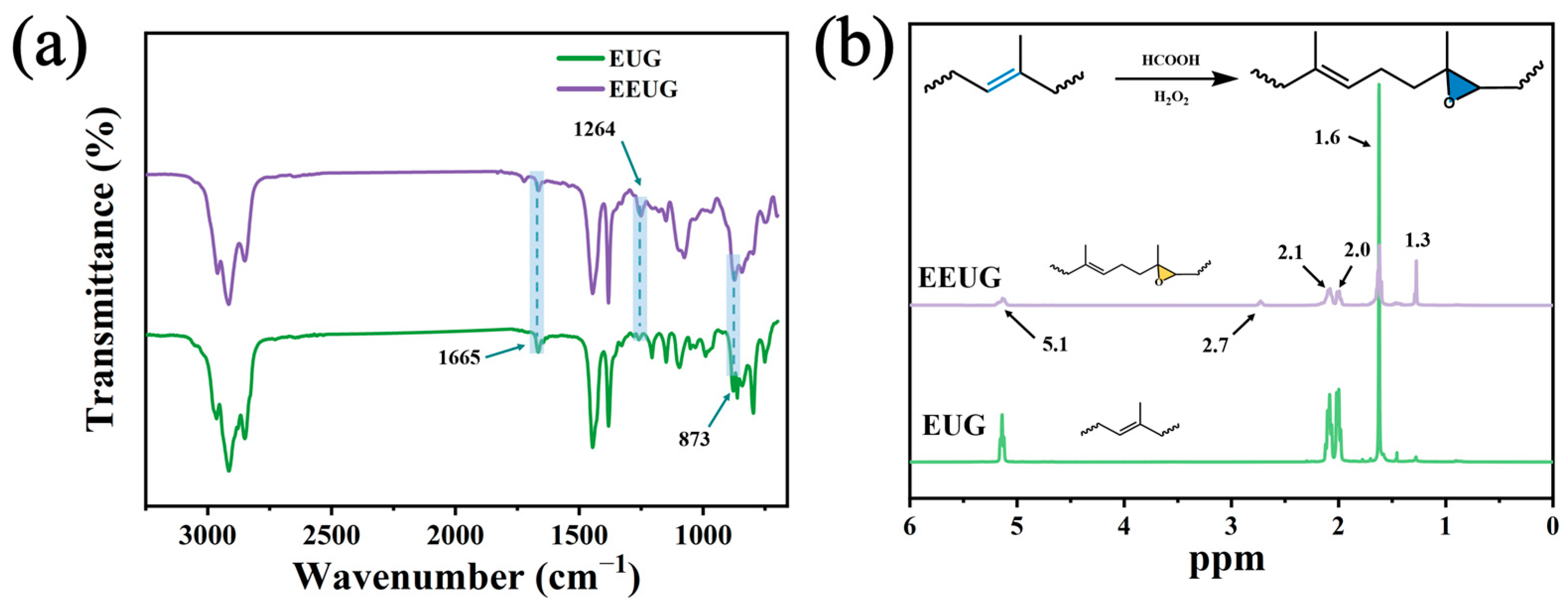


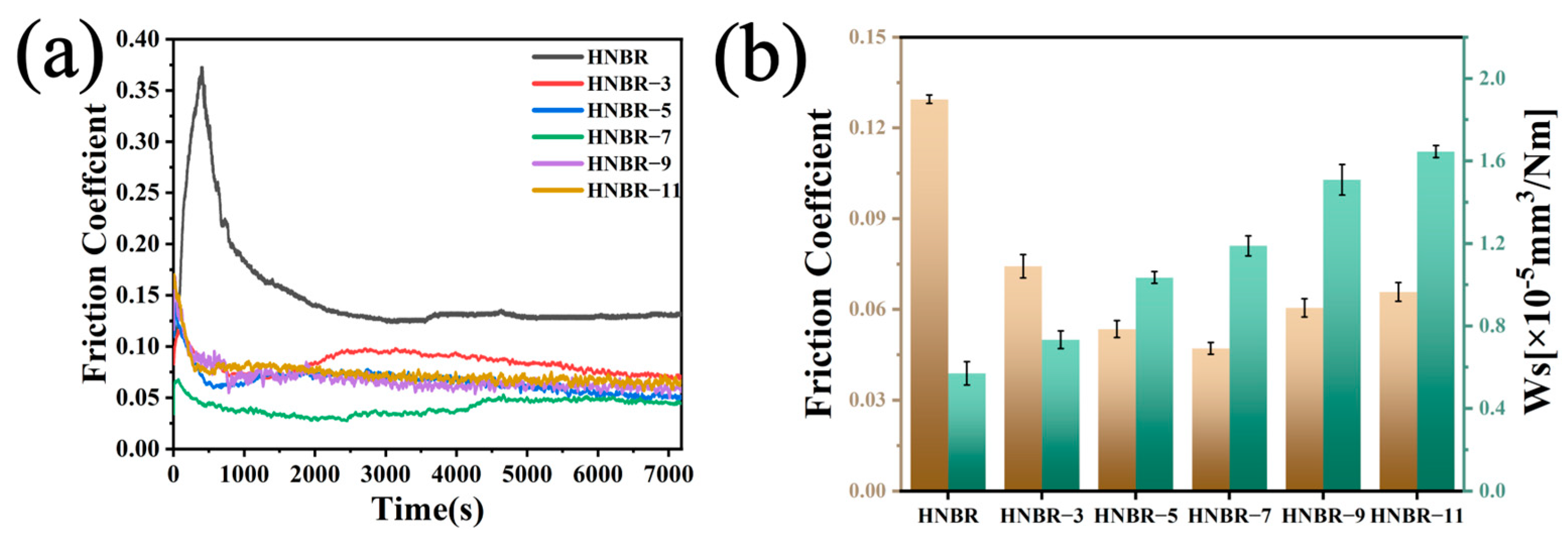
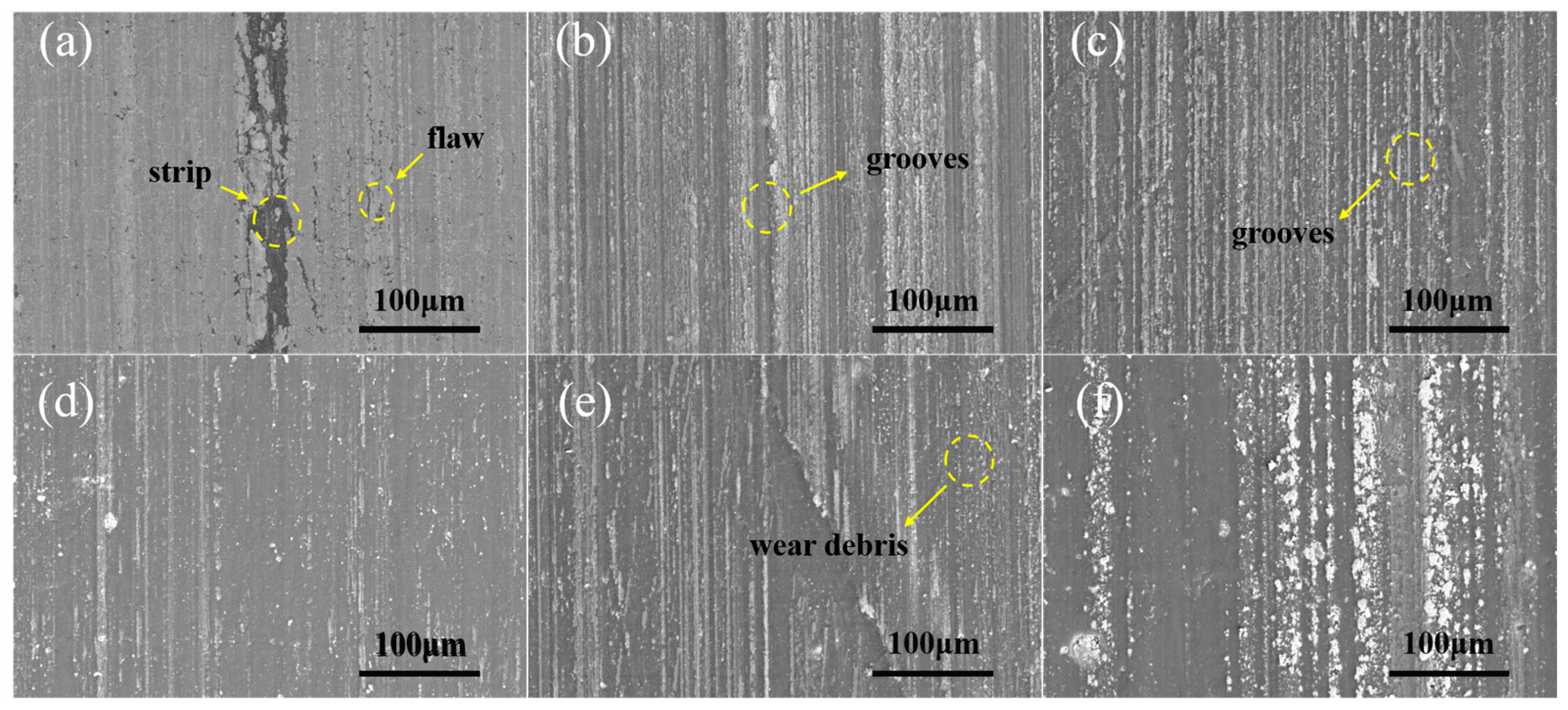



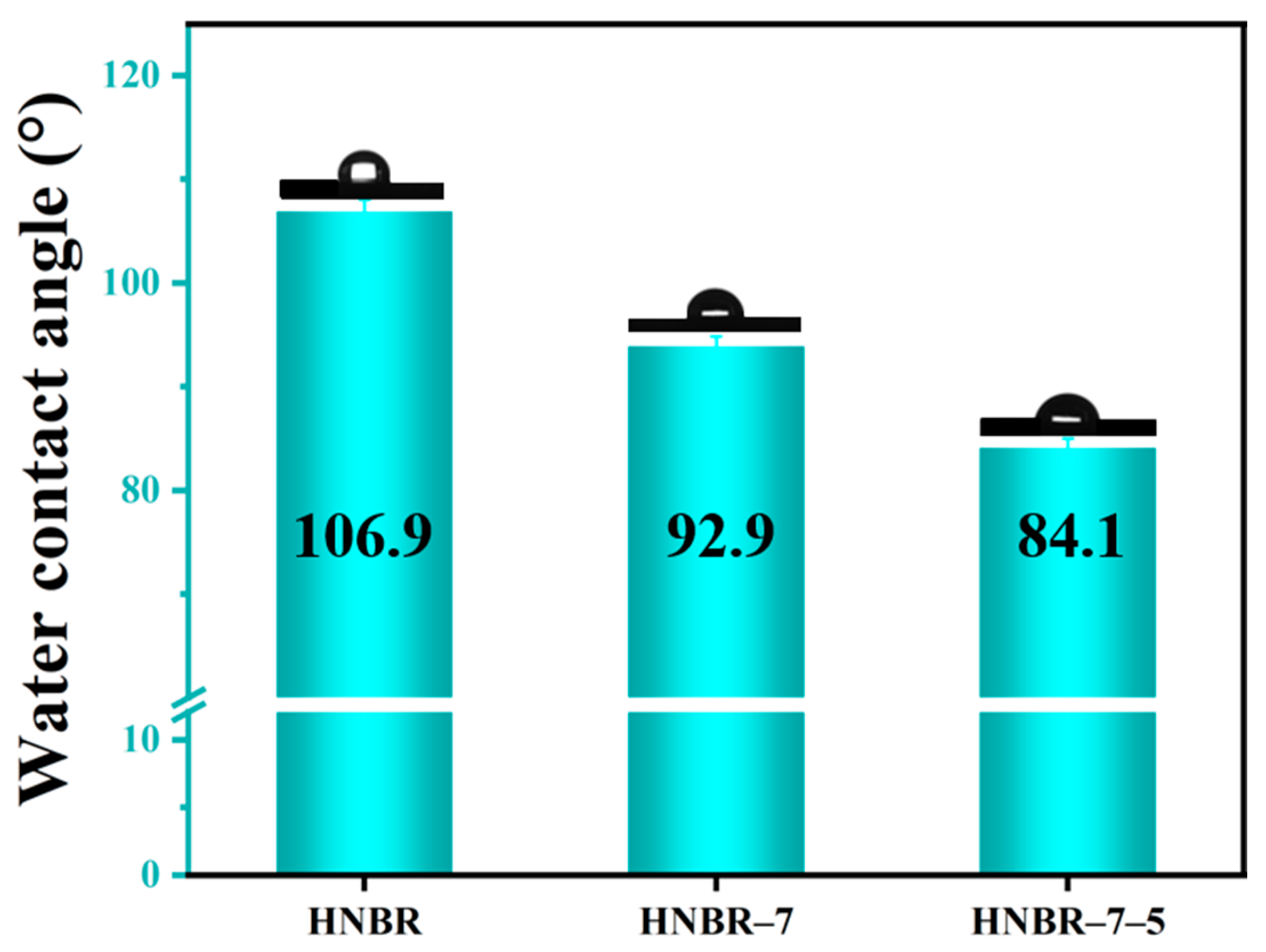

| Samples (phr) | HNBR | EEUG | HER | S | MOCA | SA | ZnO | TMTD | CB220 | MBT |
|---|---|---|---|---|---|---|---|---|---|---|
| 100:0:0 | 100 | 0 | 0 | 2 | 0 | 0.8 | 2.5 | 0.65 | 60 | 0.45 |
| 100:7:0 | 100 | 7 | 0 | 2.14 | 2.8 | 0.8 | 2.5 | 0.65 | 60 | 0.45 |
| 100:7:5 | 100 | 7 | 5 | 2.14 | 3.6 | 0.8 | 2.5 | 0.65 | 60 | 0.45 |
| Ingredient | Cu | Sn | Zn | Pb | Ni | Fe | Mn | Sb | S |
|---|---|---|---|---|---|---|---|---|---|
| Concentration (phr) | 83.65 | 10 | 2 | 1.5 | 2 | 0.25 | 0.2 | 0.3 | 0.1 |
| HNBR/EEUG | max | ΔT ( > 0.3) | HNBR/EEUG /HER | max | ΔT ( > 0.3) |
|---|---|---|---|---|---|
| 100:0 | 0.65 | 16.42 | 100:7 | 0.55 | 26.82 |
| 100:3 | 0.51 | 22.07 | 100:7:3 | 0.52 | 28.45 |
| 100:5 | 0.53 | 24.95 | 100:7:5 | 0.54 | 30.80 |
| 100:7 | 0.55 | 26.82 | 100:7:7 | 0.52 | 29.85 |
| 100:9 | 0.58 | 23.87 | 100:7:9 | 0.48 | 27.24 |
| 100:11 | 0.60 | 24.08 | - | - | - |
Disclaimer/Publisher’s Note: The statements, opinions and data contained in all publications are solely those of the individual author(s) and contributor(s) and not of MDPI and/or the editor(s). MDPI and/or the editor(s) disclaim responsibility for any injury to people or property resulting from any ideas, methods, instructions or products referred to in the content. |
© 2023 by the authors. Licensee MDPI, Basel, Switzerland. This article is an open access article distributed under the terms and conditions of the Creative Commons Attribution (CC BY) license (https://creativecommons.org/licenses/by/4.0/).
Share and Cite
Yu, H.; Zheng, W.; Zhang, C.; Chen, S.; Tian, G.; Wang, T. Dual Network Co-Crosslinked HNBR Composites with Enhanced Tribological Properties under Water Lubrication. Lubricants 2023, 11, 534. https://doi.org/10.3390/lubricants11120534
Yu H, Zheng W, Zhang C, Chen S, Tian G, Wang T. Dual Network Co-Crosslinked HNBR Composites with Enhanced Tribological Properties under Water Lubrication. Lubricants. 2023; 11(12):534. https://doi.org/10.3390/lubricants11120534
Chicago/Turabian StyleYu, Hao, Wuxuan Zheng, Caixia Zhang, Shoubing Chen, Guangke Tian, and Tingmei Wang. 2023. "Dual Network Co-Crosslinked HNBR Composites with Enhanced Tribological Properties under Water Lubrication" Lubricants 11, no. 12: 534. https://doi.org/10.3390/lubricants11120534





